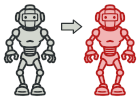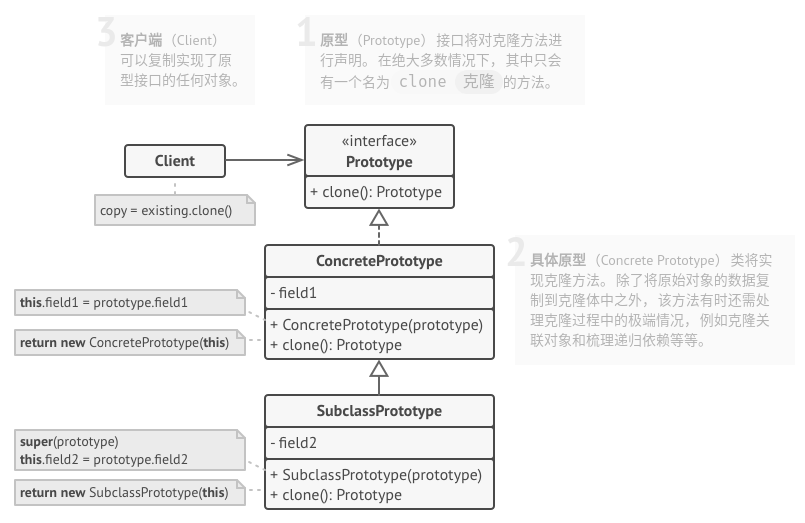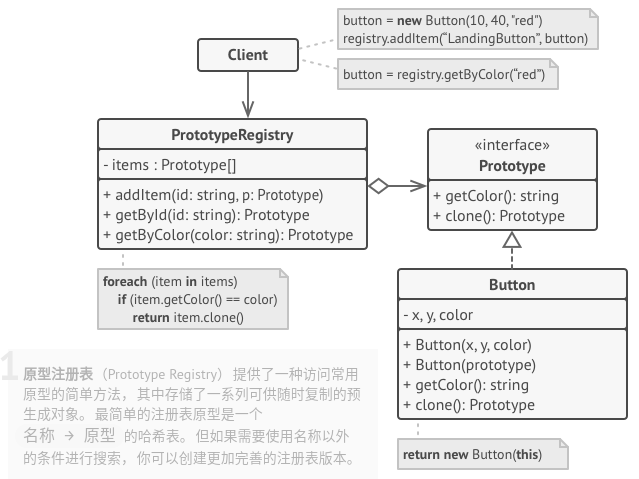原型模式
简介

原型模式通过复制一个已有对象来获取更多相同或者相似的对象。
原型模式:使用原型实例指定待创建对象的类型,并且通过复制这个原型创建新的对象。
结构


实现
实现方式:
- 创建原型接口,并在其中声明克隆方法。如果你已有类层次结构,则只需在其所有类中添加该方法即可。
- 原型类必须另行定义一个以该类对象为参数的构造函数。构造函数必须复制参数对象中的所有成员变量值到新建实体中。如果你需要修改子类,则必须调用父类构造函数,让父类复制其私有成员变量值。
- 克隆方法通常只有一行代码:使用
new运算符调用原型版本的构造函数。注意,每个类都必须显式重写克隆方法并使用自身类名调用new运算符。否则,克隆方法可能会生成父类的对象。 - 还可以创建一个中心化原型注册表, 用于存储常用原型。
#include <iostream>
#include <unordered_map>
enum Type {
PROTOTYPE_1 = 0,
PROTOTYPE_2
};
class Prototype {
protected:
std::string prototype_name_;
float prototype_field_;
public:
Prototype() {}
Prototype(std::string prototype_name): prototype_name_(prototype_name) {}
virtual ~Prototype() {}
virtual Prototype *Clone() const = 0;
virtual void Method(float prototype_field) {
this->prototype_field_ = prototype_field;
std::cout << "Call Method from " << prototype_name_ << " with field: " << prototype_field << std::endl;
}
};
class ConcratePrototype1 : public Prototype {
private:
float concrete_prototype_field1_;
public:
ConcratePrototype1(std::string prototype_name, float concrete_prototype_field): Prototype(prototype_name), concrete_prototype_field1_(concrete_prototype_field) {}
Prototype *Clone() const override {
return new ConcratePrototype1(*this);
}
};
class ConcratePrototype2 : public Prototype {
private:
float concrete_prototype_field2_;
public:
ConcratePrototype2(std::string prototype_name, float concrete_prototype_field): Prototype(prototype_name), concrete_prototype_field2_(concrete_prototype_field) {}
Prototype *Clone() const override {
return new ConcratePrototype2(*this);
}
};
class PrototypeFactory {
private:
std::unordered_map<Type, Prototype*, std::hash<int>> prototypes_;
public:
PrototypeFactory() {
prototypes_[Type::PROTOTYPE_1] = new ConcratePrototype1("PROTOTYPE_1", 50.f);
prototypes_[Type::PROTOTYPE_2] = new ConcratePrototype2("PROTOTYPE_2", 60.f);
}
~PrototypeFactory() {
delete prototypes_[Type::PROTOTYPE_1];
delete prototypes_[Type::PROTOTYPE_2];
}
Prototype *CreatePrototype(Type type) {
return prototypes_[type]->Clone();
}
};
void ClientCode(PrototypeFactory &prototype_factory) {
std::cout << "Let`s create a Prototype 1
";
Prototype *prototype = prototype_factory.CreatePrototype(Type::PROTOTYPE_1);
prototype->Method(90);
delete prototype;
std::cout << std::endl;
std::cout << "Let`s create a Prototype 2
";
prototype = prototype_factory.CreatePrototype(Type::PROTOTYPE_2);
prototype->Method(10);
delete prototype;
std::cout << std::endl;
}
int main(int argc, char *argv[]) {
PrototypeFactory *prototype_factory = new PrototypeFactory();
ClientCode(*prototype_factory);
delete prototype_factory;
return 0;
}
# -*- coding: UTF-8 -*-
import copy
class SelfReferencingEntity:
def __init__(self):
self.parent = None
def set_parent(self, parent):
self.parent = parent
class SomeComponent:
"""
"""
def __init__(self, some_int, some_list_of_objects, some_circular_ref):
self.some_int = some_int
self.some_list_of_objects = some_list_of_objects
self.some_circular_ref = some_circular_ref
def __copy__(self):
"""
"""
# 创建嵌套对象的副本
some_list_of_objects = copy.copy(self.some_list_of_objects)
some_circular_ref = copy.copy(self.some_circular_ref)
# 使用准备好的嵌套对象克隆来克隆对象本身
new = self.__class__(
self.some_int, some_list_of_objects, some_circular_ref
)
new.__dict__.update(self.__dict__)
return new
def __deepcopy__(self, memo={}):
"""
"""
# 创建嵌套对象的副本
some_list_of_objects = copy.deepcopy(self.some_list_of_objects, memo)
some_circular_ref = copy.deepcopy(self.some_circular_ref, memo)
# 使用准备好的嵌套对象克隆来克隆对象本身
new = self.__class__(
self.some_int, some_list_of_objects, some_circular_ref
)
new.__dict__ = copy.deepcopy(self.__dict__, memo)
return new
if __name__ == "__main__":
list_of_objects = [1, {1, 2, 3}, [1, 2, 3]]
circular_ref = SelfReferencingEntity()
component = SomeComponent(23, list_of_objects, circular_ref)
circular_ref.set_parent(component)
shallow_copied_component = copy.copy(component)
# 更改列表,检查是否发生变化
shallow_copied_component.some_list_of_objects.append("another object")
if component.some_list_of_objects[-1] == "another object":
print("已发生变化")
else:
print("未发生变化")
# 在对象列表中更改设置
component.some_list_of_objects[1].add(4)
if 4 in shallow_copied_component.some_list_of_objects[1]:
print("已发生变化")
else:
print("未发生变化")
deep_copied_component = copy.deepcopy(component)
deep_copied_component.some_list_of_objects.append("one more object")
if component.some_list_of_objects[-1] == "one more object":
print("已发生变化")
else:
print("未发生变化")
component.some_list_of_objects[1].add(10)
if 10 in deep_copied_component.some_list_of_objects[1]:
print("已发生变化")
else:
print("未发生变化")
print("id(deep_copied_component.some_circular_ref.parent): {0}".format(id(deep_copied_component.some_circular_ref.parent)))
print("id(deep_copied_component.some_circular_ref.parent.some_circular_ref.parent): {0}".format(id(deep_copied_component.some_circular_ref.parent.some_circular_ref.parent)))
实例
问题描述
如果用过类似于Photoshop的平面设计软件,一定都知道图层的概念。图层概念的提出,使得设计、图形修改等操作更加便利。设计师既可以修改和绘制当前图像对象,又可以保留其它图像对象,逻辑清晰,且可以及时得到反馈。
问题解答
# Example.py
# -*- coding: utf-8 -*-
from copy import copy, deepcopy
class SimpleLayer:
background = [0, 0, 0, 0]
content = "blank"
def get_content(self):
return self.content
def get_background(self):
return self.background
def paint(self, painting):
self.content = painting
def set_background(self, background):
self.background[3] = background
def fill_background(self, background):
self.background = background
def clone(self):
return copy(self)
def deep_clone(self):
return deepcopy(self)
if __name__ == "__main__":
# 一般深拷贝比浅拷贝复制得更加完全,但也更占资源(包括时间和空间资源)
# 浅拷贝:会拷贝对象内容及其内容的引用或者子对象的引用,但不会拷贝引用的内容和子对象本身
dog_layer = SimpleLayer()
dog_layer.paint("Dog")
dog_layer.fill_background([0, 0, 255, 0])
print("Original background: ", dog_layer.get_background())
print("Original Painting: ", dog_layer.get_content())
print("
")
copy_dog_layer = dog_layer.clone()
copy_dog_layer.paint("Puppy")
copy_dog_layer.set_background(128)
print("Original background: ", dog_layer.get_background())
print("Original Painting: ", dog_layer.get_content())
print("Copy background: ", copy_dog_layer.get_background())
print("Copy Painting: ", copy_dog_layer.get_content())
print("
")
# 深拷贝:不仅拷贝了对象和内容的引用,也会拷贝引用的内容
dog_layer = SimpleLayer()
dog_layer.paint("Dog")
dog_layer.fill_background([0, 0, 255, 0])
print("Original background: ", dog_layer.get_background())
print("Original Painting: ", dog_layer.get_content())
print("
")
deep_copy_dog_layer = dog_layer.deep_clone()
deep_copy_dog_layer.paint("Puppy")
deep_copy_dog_layer.set_background(128)
print("Original background: ", dog_layer.get_background())
print("Original Painting: ", dog_layer.get_content())
print("DeepCopy background: ", deep_copy_dog_layer.get_background())
print("DeepCopy Painting: ", deep_copy_dog_layer.get_content())
总结
优点
- 当创建新的对象实例较为复杂时,原型模式可以简化创建过程,提高创建对象的效率。
- 模式中提供了抽象原型类,具体原型类可适当拓展。
- 创建结构简单:创建工厂即为原型对象本身。
缺点
- 深拷贝代码较为复杂。
- 每一个类都必须有一个Clone方法,且该方法位于类的内部,修改时违背开闭原则。
场景
- 如果你需要复制一些对象, 同时又希望代码独立于这些对象所属的具体类, 可以使用原型模式。
- 如果子类的区别仅在于其对象的初始化方式, 那么你可以使用该模式来减少子类的数量。 别人创建这些子类的目的可能是为了创建特定类型的对象。
- 对象在修改过后,需要复制多份的场景。当创建新的对象实例较为复杂时,原型模式可以简化创建过程。
与其他模式的关系
- 在许多设计工作的初期都会使用工厂方法模式(较为简单, 而且可以更方便地通过子类进行定制),随后演化为使用抽象工厂模式、原型模式或生成器模式(更灵活但更加复杂)。
- 抽象工厂模式通常基于一组工厂方法,但你也可以使用原型模式来生成这些类的方法。
- 原型可用于保存命令模式的历史记录。
- 大量使用组合模式和装饰模式的设计通常可从对于原型的使用中获益。你可以通过该模式来复制复杂结构,而非从零开始重新构造。
- 原型并不基于继承,因此没有继承的缺点。另一方面,原型需要对被复制对象进行复杂的初始化。工厂方法基于继承,但是它不需要初始化步骤。
- 有时候原型可以作为备忘录模式的一个简化版本,其条件是你需要在历史记录中存储的对象的状态比较简单,不需要链接其他外部资源,或者链接可以方便地重建。
- 抽象工厂、生成器和原型都可以用单例模式来实现。